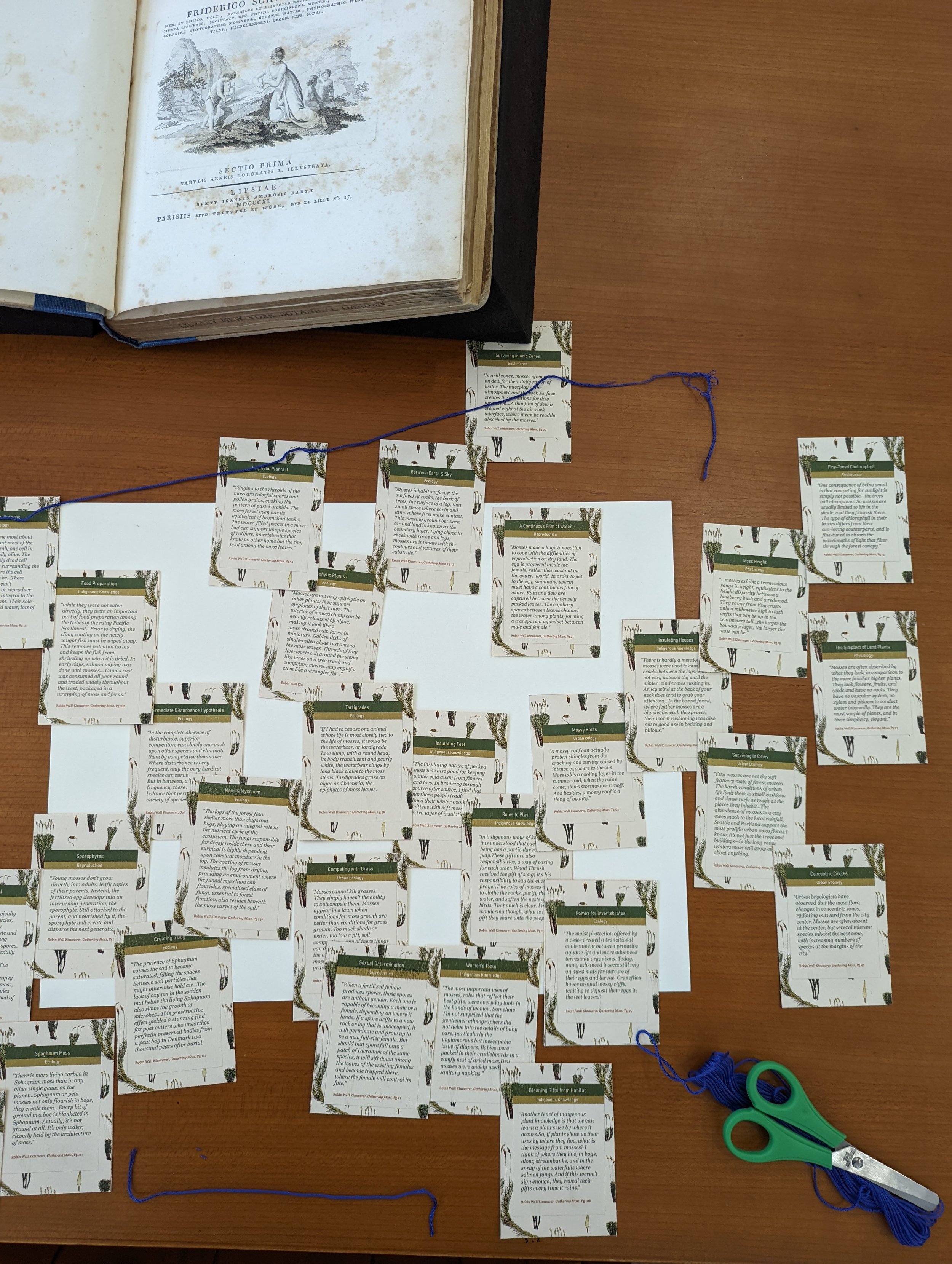Pilot Workshop
Bronx Botanical Gardens, May 20, 2022
We designed our pilot workshop with the intention of introducing participants to the subject matter of moss, and then trying out a series of three experimental exercises in a facilitated session that would get participants thinking around how they could arrange and structure information about moss in a visual system, make sense of archival histories, and finally, visualize new ways of arranging archival information.
We started by giving participants a tour of the Bonx Botanical Gardens, facilitated by Laura Briscoe, followed by lunch, after which we made our way to the Bronx conservatory libraries to do the exercises. Our participants for the pilot workshop were:
Dr. Shannon Mattern, The New School
Dr. Elizabeth Henaff, New York University
Ingrid Burrington, University of Delaware
Claire Hentschker, Independent Artist
Rashad Bell, New York University
Carla Gannis, New York University
Nicole Cott, CUNY
The Tour
Laura Briscoe led our group on a tour of the various conservatories, pointing to various bryophyte species and giving everyone a quick overview of the history of bryophytic science, including the specific history of the Mitten Collection, and the ways in which indigenous knowledge and women’s work helped constitute modern knowledge on bryophytes. Laura also talked about moss physiology, its resilience and adaptability, how it clones and perpetuates itself and the role of air and water in its reproduction, and its ecological role as a tiny but essential part of larger ecosystems, residing and growing on all sorts of substrates like stone and bark, and acting as a substrate for microecologies of epiphytes, insects, and amphibians.
The Exercises
The first exercise had participants working in groups and going through a card deck that we had designed with facts and observations on moss physiology, ecology, and history, taken from a selection of sources, principal of which was Robin Wall Kimmerer’s book Gathering Moss.
We instructed participants to take around half an hour to go through the deck of 75 cards, and then come up with a schema to categorize and structure them according to how they best made sense, with the ultimate aim of then creating a visual model that would show the relationships between the cards, as well as get us to start thinking about forms of representing lots of different kinds of information.
Moss As A System
Moss & Other Subjects
We then had groups work with a second deck of materials and resources taken from the Mitten collection and conservatory archives, which largely dealt with the communications between moss collectors in England, the women they had employed to help classify and categorize them, the contracted men in the colonies tasked with collecting and shipping the moss, and the indigenous gatherers whose knowledge of where to find moss in the wild was invaluable.
We used the printed materials to hold a facilitated conversation about the issues around the colonial production of knowledge they each raised and\or represented. Questions we asked our participants: what speaks to you from the card you picked? What can you relate to it from your own disciplinary perspective? How do the issues raised make you think about issues of data collection, translation and interpretation, archival, dissemination etc. in your field? What would you want publics to be aware of or know about?
Moss As A Metaphor
The last part of our workshop had participants work individually, using moss as a metaphor to think through the (re)design of digital archives. Using both the model they had created collectively in the first exercise, as well as the takeaways from the discussion from the second exercise, we prompted them to create a response: write a set of provocations or questions, create a sketch or drawing, or make something tangible from the supplied materials, that spoke to a chosen prompt or question we had provided.
Some examples of the questions we posed for this exercise: who participates in knowledge production, and who has access to that knowledge across institutions and systems of power? How do the stories that we tell change when we look beyond economically valuable objects and consider the roles that Indigenous communities, women, or working-class amateurs played in the construction of what we know? How does privileging the commonplace, tiny, and invisible tell radically new and productive histories of translation, migration, representation, and communication across centuries?
Followup & Takeaways
Most of our participants chose to create written and visual responses to the last part of the workshop. One participant gave us a range of concepts and keywords that came to her in thinking through moss in relation to digital systems: recursion, generous interfaces, and distributed intelligence. Another participant, who was a VR artist, drew sketches and wrote down notes on the affordances of 3-dimensional virtual space, and talked about the possibility of representing plural perspectives via accessing information through specific VR avatars, as well as the possibility of having the latter as vehicles for telling different stories about history.
We found that several core themes emerged out of the workshop that participants brought up again and again. Moving between different scales (micro to macro), as well as thinking of scale along different dimensions, not only spatial but temporal and informational, and in terms of orders of complexity; representing perspectives through different actors that ‘speak for’ moss, as well as wondering what kinds of conversations non-humans could have; and thinking about the affordances of different media, digital, virtual and computational, and how different mediums could allow audiences to experience the stories that historians of science tell, were all conversations that emerged out of the pilot. These conversations were instrumental in helping us refine our exercises and think through the kinds of questions and provocations we wanted to raise in subsequent workshops.












